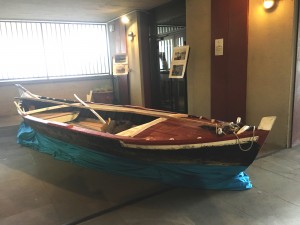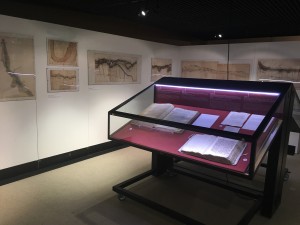
Archivio di Stato di Firenze
9 ottobre 2016 – 4 febbraio 2017
Di Tania Mio Bertolo (Università degli Studi di Firenze)
A cinquant’anni dalla disastrosa alluvione dell’Arno Firenze e le sue Istituzioni ricordano questo doloroso episodio della recente storia cittadina attraverso convegni, conferenze e mostre. Una di queste trova spazio in alcuni ambienti espositivi del piano terreno dell’Archivio di Stato che, attraverso il contributo di altri enti e istituti scientifici, coglie l’occasione per ripercorrere con ampio sguardo la storia e la geografia del fiume toscano.
L’esposizione si articola in tre grandi sezioni: principia con un percorso storico inerente l’Arno, il suo rapporto con il territorio e con gli uomini, il suo contributo alla vita economica, sociale ed ambientale; prosegue con una raccolta di testimonianze eterogenee circa le inondazioni del fiume dal 1177 al ventesimo secolo; e si conclude con un approfondimento sull’alluvione del 1966 e su quelle che successivamente hanno colpito le aree percorse dal fiume. Si tratta dunque di un obiettivo museologico e formativo di ampio respiro, perseguito attraverso il consistente utilizzo di materiale d’archivio come cartografie e volumi manoscritti, messo esso stesso in mostra con il fine e di valorizzare l’utilizzo delle fonti, e di esporre attraverso testimonianze concrete gli irrecuperabili danni causati dalle violente acque che inondarono nel ’66 le quaranta sale conservative degli Uffizi.
Una mostra francamente non facile da seguire e da capire, proprio per tale preponderante uso di materiale archivistico. Probabilmente pensate per facilitare il godimento dell’esposizione da parte del visitatore, testimonianze di carattere eterogeneo come fotografie, dipinti, filmati, modellini architettonici, locandine di teatro, acqueforti e litografie arricchiscono il percorso espositivo. Purtroppo l’effetto raggiunto è quello di un pentolone pieno d’ogni cosa. Già all’ingresso, nella sottosezione dedicata agli omaggi letterari e artistici all’Arno, tra gli altri oggetti in mostra si trovano pannelli che riportano citazioni di Dante e altri poeti estrapolate e stampate come slogan pubblicitari. Una scelta discutibile, se si pensa che la maggior parte degli oggetti esposti è composta da carte e fogli manoscritti originali. A chiudere la prima sezione è posta la ristampa in grande formato di una fotografia che ritrae i fuochi d’artificio esplosi sopra Ponte Vecchio, immagine che starebbe d’incanto nelle cartoline turistiche. L’ultima sezione si snoda in un lungo corridoio e, ahimè, anche qui pare di giocare a “chi più ne ha, più ne metta”. Mentre sulla parete sinistra si succedono teche entro le quali sono esposti alcuni tra i volumi manoscritti irrecuperabilmente danneggiati dall’alluvione del 1966, i quali rappresentano importanti testimonianze storiche e motivo di riflessione per il visitatore, sulla parete destra invece si alternano, tra le altre, grandi ristampe e collage su cartoncino chiaro di fotografie di piccolo formato. A chiudere la mostra è posta un’autentica barca in legno, già usata per percorrere l’Arno.
Pare proprio di dover dar ragione a chi dice che “il troppo stroppia”. Apprezzabile è la volontà di mostrare ai più l’enorme vastità del materiale archivistico fortunamente sopraggiunto oggigiorno, e sottolinearne il valore e le infinite potenzialità, utili come in questo caso per ricostruire la storia dell’Arno. Ed è comprensibile la necessità di diversificare il percorso espositivo con l’inserimento di una varietà di oggetti museali. Ma gli oggetti in mostra dovrebbero effettivamente essere selezionati per qualità formativa ed informativa, non per finalità numeriche e scenografiche.

Archivio di Stato di Firenze
October 9, 2016 – February 4, 2017
Translation by Rachyl Grussing (Istituto Lorenzo de’ Medici)
Fifty years since the disastrous flood of the Arno River in Florence, and the city’s institutions remembered this painful episode of recent history through meetings, conferences, and exhibitions. One of these is found in the exhibition space on the first floor of the State Archives, through the contributions of scientific institutions and other establishments, and the occasion captures, with wide eyes, the history and geography of the Tuscan river.
The exhibition is articulated in three grand sections: the first through the history inherent in the Arno, his relationship with the territory and with the people, his contribution to the economy and the social and environmental life; it continues with a collection of heterogenous testimonies about the flooding of the river from 1177 to the twentieth century; and it concludes with a study of the flood in the 1966 and what subsequently hit the area traversed by the river. Therefore, it handles an educational museological target, pursued through the consistent use of archival materials such as maps and volume manuscripts; the archives put itself on display with the intention of utilizing the sources, to expose through concrete materials the irrevocable damage caused by the violent waters in ‘66 to the forty conservation halls of the Uffizi.
Frankly, it is not an easy show to follow and to understand because of the predominate use of archival material. It probably thinks to facilitate the enjoyment of the exhibition on the part of the visitor, evidenced by the heterogenous nature of the photographs, paintings, films, architectural models, theater posters, etchings and lithographs that enrich the exhibition. Unfortunately, the effect achieved is that of a pot full of everything. Already at the entrance, in the subsection dedicated to the literary and artistic gifts of the Arno, between the other objects of the show we find panels that quote Dante, and other poets extrapolated, printed as advertizing slogans. A questionable choice, if you think about the larger portion of the exhibition which consists of card sheets and original manuscripts. To close the first section is grand reprinting of a photograph of fireworks exploding over the Ponte Vecchio, an image that would look charming on postcards. The last sections runs in a long corridor and, alas, here it also seems to play ‘and so on and so forth’. While on the left wall are showcases displaying within some of the manuscripts irrevocably damaged by the flood of 1966, which represent important historical testimonies and motive for reflection for the visitor; the right wall instead has alternate large reprints and collage on light cardboard of small format photographs. The end of the exhibition is placed in a large boat, used in crossing the Arno.
It seems to agree with those who say that ‘the good things too’. Appreciable is the will to show the enormous vastness of the archival material which fortunately came to the archives, and highlight the value and infinite potential, useful as in this case, to reconstruct the history of the Arno. It is understandable the necessity to diversify the exhibition with the inclusion of various museological objects. But the objects in the exhibition should be selected for the quality and type of information, rather than for scenic and numeric value.
